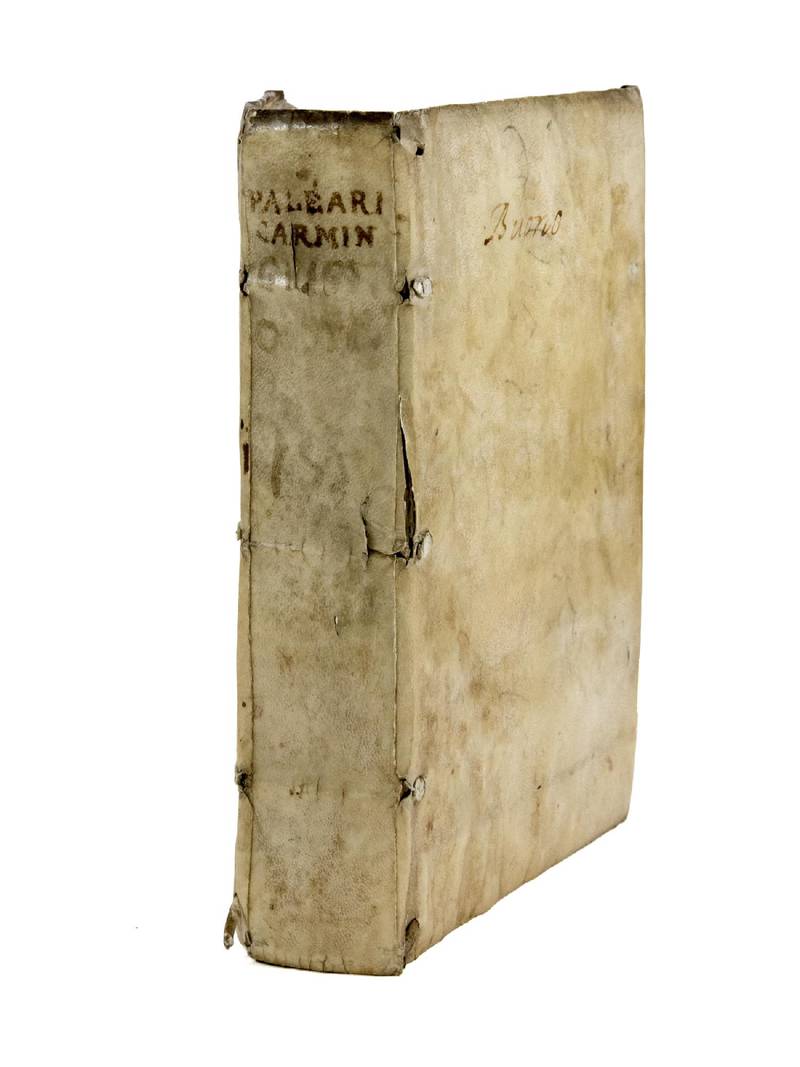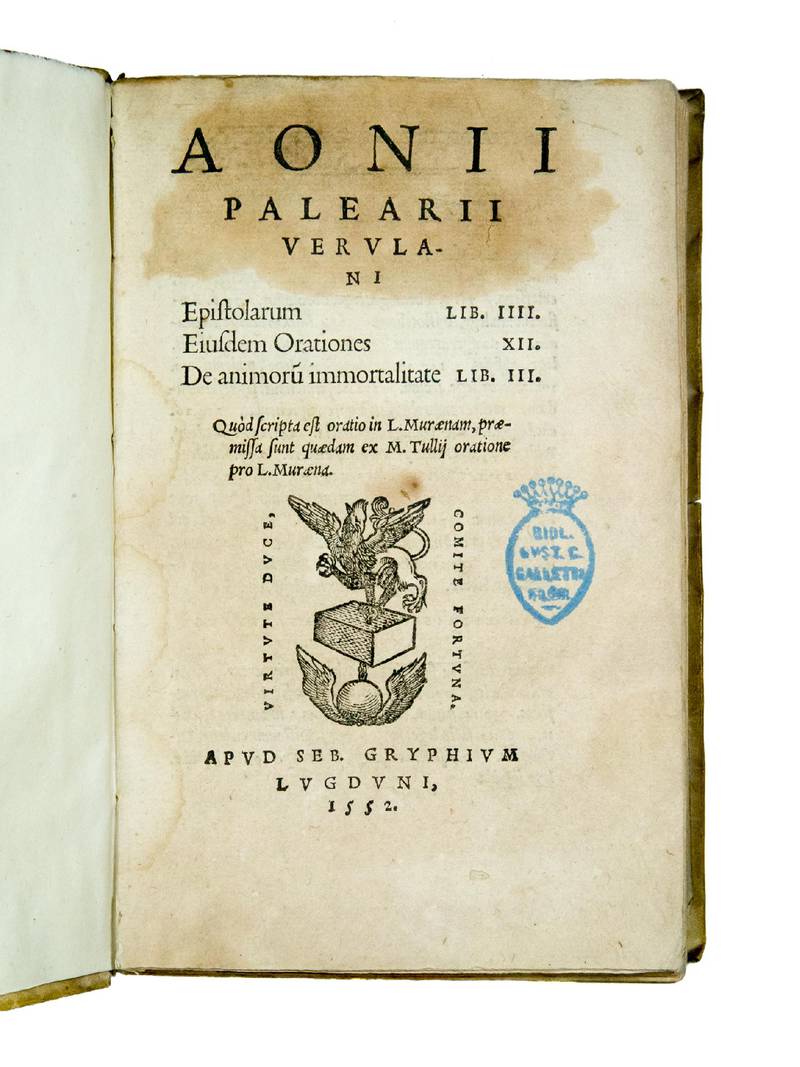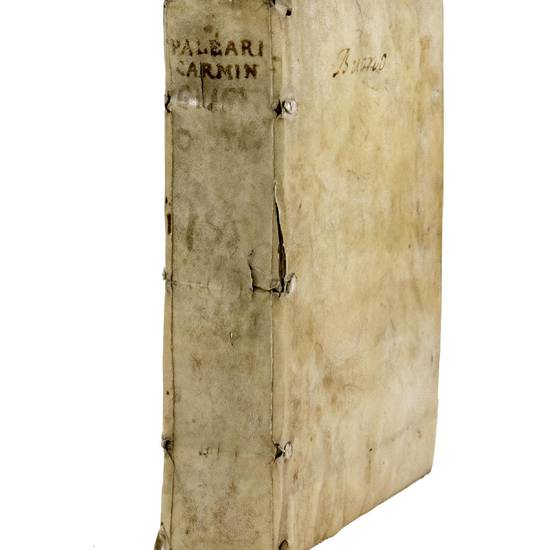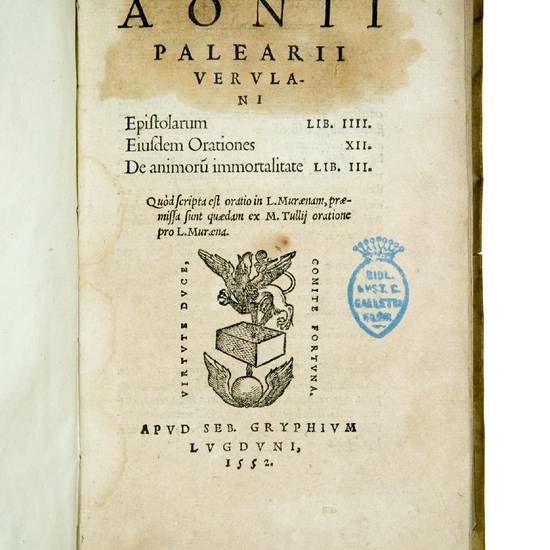Two parts in one volume, 8vo. 456 pp. (Epistolae and Orationes) + 98, (2) pp. (De animorum immortalitate libri III). a-z8, A-E8, F4, aa-ff8, gg2. With the printer's device on the title-pages and at the end. Contemporary limp vellum with overlapping edges, manuscript title on spine. Ex-libris Galletti-Landau.
E. Gallina, Aonio Paleario, Vol. I: Bibliografia, biografia, opere, (Sora, 1989), pp. 23-24, no. 1.
FIRST EDITION of Paleario's letters and orations (among them the famous apology Pro se ipso) and third edition of his major work, De animorum immortalitate libri III. Other editions with the same content appeared in the following years in Basle: Johann Oporinus [ca. 1564], Thomas Guarin [ca. 1567] and [ca. 1571]. The volume is dedicated by Paleario to the editor Sébastien Gryphe.
The collection, divided into 4 books, gathers overall 78 letters, of which 20 are addressed by different senders to Paleario. One letter is addressed by Marco Casali to Paleario's family.
Le “lettere… furono raccolte dal Paleario stesso, a scopo autobiografico (vi ritroviamo il racconto degli avvenimenti della sua vita, dipinti con i colori della tavolozza di Cicerone!), con un criterio di approssimazione cronologica, e dietro opportuni ritocchi e rimaneggiamenti. In moltissime manca la data; in nessuna è segnato l'anno” (E. Gallina, op. cit., p. 781; see also pp. 782-786).
(Book I:)
Mauro d'Arcano, [Giovanni]. Roma, [August, 1525?] (p. 7)
id. Roma, [a. May 28, 1526] (p. 9)
id. [Roma] (p. 11)
id. Roma, [1529] (p. 14)
id. Perugia, [p. February 14, 1530] (p. 16)
Frangipani, Cinzio. Siena, [a. September 26, 1533] (p. 19)
Filonardi, Ennio, Bishop of Veroli. Siena (p. 21)
Frangipani, Cinzio. Siena, [a. September 26, 1533] (p. 23)
Boni, Francesco and Pavoni, Matteo. [Siena, end of 1530] (p. 26)
Martelli, Giovanni. (p. 29)
Maffei, Bernardino. [Siena, p. Summer 1532] (p. 30)
Pterix Gallus. [1533] (p. 32)
Mauro d'Arcano, [Giovanni]. Siena, [September, 1533] (p. 34)
Lampridio, Giovanni [Benedetto]. Siena, [a. October 27, 1533] (p. 36)
Bembo, Pietro. Siena, December 25, [1533] (p. 38)
from Bembo, Pietro. [1533-1534] (p. 39)
from Maffei, Bernardino. Roma, March 5, [1536] (p. 41)
Maffei, Bernardino. Padova, February 1, [1536] (p. 43)
(Book II:)
Sadoleto, Jacopo. Padova, February 11, [1536] (p. 46)
id. Siena, [a. Spring, 1536] (p. 48)
from Sadoleto, Jacopo. Carpentras, May 27, [1536] (p. 49)
Mellini, Pietro. October 25, [1537] (p. 51)
from Mellini, Pietro. Roma, November 18, [1537] (p. 55)
Sadoleto, Paolo. Siena, June 11, [1536] (p. 57)
Filonardi, Ennio. Siena, March 1, [1538] (p. 60)
Sadoleto, Jacopo. Cecignano, July 5, [1538] (p. 63)
Giovannini, Luca, Bishop. Cecignano, [1538] (p. 65)
Vettori, Pier. Colle Val d'Elsa, December 25, [1535] (p. 66)
from Vettori, Pier. [Firenze], January 22, [1536] (p. 68)
Vettori, Pier. Cecignano, February 21, [1536] (p. 70)
Verino, Francesco. Colle Val d'Elsa, April 11 (p. 73)
id. (p. 75)
Panciatichi, Bartolomeo. Colle Val d'Elsa, April 18 (p. 79)
Bembo, Pietro. [1539] (p. 81)
Filonardi, Antonio, Bishop of Veroli. Siena, July 28 (p. 84)
(Book III:)
Ricci, Pier Francesco. Colle Val d'Elsa, August 3, [1541] (p. 87)
Campani, Francesco. Siena, September 4, [1541] (p. 91)
from Bellanti, Fausto. Areola castle, [1541] (p. 92)
Bellanti, Fausto. Roma, February 13, [1541] (p. 94)
from Bellanti, Fausto. [1541] (p. 96)
Bellanti, Fausto. [Roma?, 1541] (p. 99)
id. Roma, March 6, [1541] (p. 101)
Pterix Gallus. [Roma] (p. 104)
id. [Viterbo, a. May 1542] (p. 105)
Thomas, Magister Sacri Palatii (Master of the Sacred Palace). [Viterbo, a. May 1542] (p. 107)
Pterix Gallus. (p. 114)
Bandini [Piccolomini], Francesco, Archbishop of Siena. Colle Val d'Elsa, [2nd half of 1542] (p. 115)
Malavolta, Orazio. Colle Val d'Elsa, [1542] (p. 121)
from Placido, Antonio. Siena, [1542] (p. 124)
Placido, Antonio. [1542] (p. 128)
Corsini, Francesco. Areola Castle, July 25, [1543] (p. 133)
Visconti, Alessandro, Governor of Siena. From the Argiano of Bellanti, April 10, [1544] (p. 137)
(Book IV:)
Senatui Populoque Lucensi (to the Senate and People of Lucca). [between July 29 and August 15, 1546] (p. 143)
from Sadoleto, Jacopo. [October, 1546] (p. 146)
Gigli, Silvestro. [Lucca, Autumn-Winter, 1547] (p. 150)
Ricci, Bartolomeo. Lucca, October 6, [1548] (p. 153)
from Ricci, Bartolomeo. Ferrara, October 1, [1549] (p. 156)
from id. May 1, [1548] (p. 160)
Ricci, Bartolomeo. [1550] (p. 163)
from Ricci, Bartolomeo. Ferrara, November 30 (p. 165)
Pterix Gallus. Lucca, May 7, [1554] (p. 166)
from Gaddi, Giovanni Battista. Ex Pancratiano Arnulphini, June 1, [1547] (p. 169)
Gaddi, Giovanni Battista. Lucca, June 2, [1547] (p. 172)
from Gaddi, Giovanni Battista. Ex Pancratiano Arnulphini, [1547] (p. 174)
from Pagani, Pagano. Pisa, March 18, [1547] (p. 175)
Pagani, Pagano. Lucca, March 25, [1547] (p. 180)
from Pagani, Pagano. Pisa, May 1, [1547] (p. 184)
Giovio, Giuseppe. [1547] (p. 185)
from Corsini, Francesco. Bauco, December 26, [1548] (p. 187)
Corsini, Francesco. Lucca, February 13, [1549] (p. 189)
Alciati, Andrea. [1547] (p. 192)
from Alciati, Andrea. Pavia, October 1, [1547] (p. 194)
Maffei, Bernardino. Lucca, March 7, [1550] (p. 196)
from Maffei, Bernardino. Roma, April 20, [1550] (p. 199)
from Casali, Marco to Paleario's family (Vidottis suis). [Lucca, 1548] (p. 202)
from Orgetorix Sphinter. [Köln, 1548] (p. 204)
Orgetorix Sphinter. [1548] (p. 206)
Pterix Gallus. [Autumn, 1550?] (p. 208)
Antonio della Pagliara (or Paglia) is best known under the humanist name of Aonius Palearius. He was born in Veroli near Frosinone. From 1520 to 1529 he studied humanities at the University of Rome. Then for one year he entered the service of Ennio Filonardi, governor of Perugia. In 1530 he moved to Siena, where he found employment as a teacher. Until 1536 he lived between Siena and Padua, where he continued his studies and in 1535 made the acquaintance of Pietro Bembo. In the same period he wrote his major work, the De animorum immortalitate libri III, first published in a private undated edition around 1535, then reprinted by Gryphe in Lyons in 1536.
In Padua Paleario involved himself in religious debates and read the work of Luther and Erasmus. In 1537 he married Marietta Guidotti and settled in Colle Val d'Elsa, where he acquired a property which he made the center of a small circle attended by sympathizers of the Reformation. In 1542 he was charged with the accusation of heresy before the archbishop of Siena Francesco Bandini Piccolomini and was released through the intervention of Jacopo Sadoleto. In 1543 he defended himself writing an oration Pro se ipso, in which he praises Erasmus and many other reformers.
Because his orthodoxy remained suspect, he did not obtain the chair of Latin at the University of Siena, but in 1546 the city council of Lucca invited him there to teach humanities. He spent the following years dividing himself between Lucca and Colle, until 1556 when he decided to move to Milan to cover the local chair of classical literature. In 1559 he had to submit to another trial for heresy and in 1567, after the publication of his works in Basel (by Thomas Guarin) without the censorships required by the Church authorities, he was imprisoned and sent to Rome. Here after two years spent in the prison of Tor di Nona, refusing to abjure, he was condemned as impenitent heretic and, on July 3, 1570, he was hanged and burned in the square in front of Ponte Sant'Angelo, the same place where only three years earlier Pietro Carnesecchi had also been executed (E. Gallina, op. cit., pp. 167-770).
[9144]





